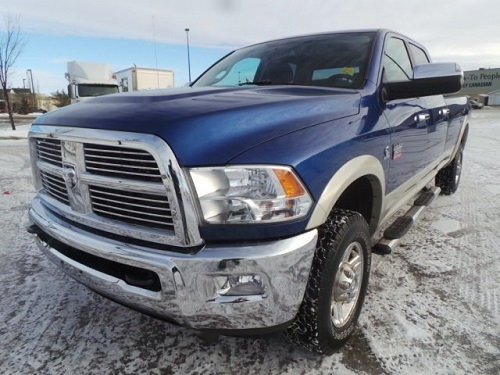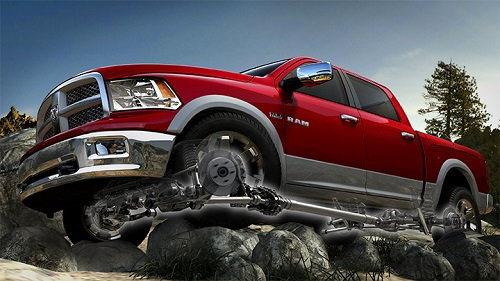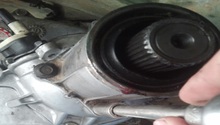Dodge Ram 2009-Present: 4WD General Information
While a four wheel drive system has its obvious benefits, understanding how it actually works is a bit confusing. If you’re considering a four wheel drive Dodge Ram, read on for some basic information about this type of vehicle.
This article applies to the Dodge Ram (2009-present).
There are several benefits to owning a four wheel drive vehicle, most notably, the improved traction the car has when driving in adverse weather conditions like snow and rain. If you’re considering buying a 4WD Dodge Ram, chances are you’ve come across some pretty confusing terminology associated with this type of car. To clear up the differences between all the various types of Ram available, read on for some background information on this technology.

How Does Four Wheel Drive Work?
The first thing to note about a four wheel drive car is that it comes equipped with a transfer case between the front and rear axles. This differs from other cars, which instead feature a differential in place. Having a transfer case allows the front and rear drive shafts to lock together when the four wheel drive system is engaged. Doing this provides the vehicle with maximum torque transfer to both axles which, in turn, gives the car excellent traction.

Difference Between Part-time and Full-time 4WD
Part time four wheel drive is the old fashioned type of 4WD, designed to be put to use when you’re already stuck, or in a situation where there is greater potential for you to get stuck (e.g. snow). It’s not designed for normal road use and has to be disengaged before driving on dry, paved roadway.
Full-time four wheel drive can basically be left on all the time. Must cars and trucks that advertise all-wheel drive feature this type of 4WD system, and don’t even give you the option to turn it off.
Differences Between 4WD Auto, 4WD Lock, and 2WD
4WD auto has a clutch design in the transfer case that allows slippage so that it won't bind up on dry pavement. You want to use it on mixed terrain like partially snow-covered roads, etc.
4WD lock has the front and rear locked together and is best used on slick surfaces like ice-covered roadway.
2WD disengages the front differential and is recommended for normal driving because it reduces drag, thereby improved MPG.

What Does the 4WD Neutral Switch Do?
In order to switch from 4WD high to 4wd low, the transmission needs to be in neutral. The neutral switch allows the switching by putting the car’s transfer case into neutral. Rule of thumb: unless you need your trucks wheels to move freely, don’t push it without first referring to the owner’s manual for the proper procedure.
Using 2WD and 4WD
When you are driving under normal weather conditions, on a well-paved roadway, have your truck in 2WD. If, however, weather conditions are a bit challenging/the roadway less than ideal for driving, engage your four wheel drive system.
Recommended Maintenance
8,000 Miles
- Change engine oil and filter.
- Rotate tires.
- Lube front drive shaft fitting (2500/3500 (4x4) models only).
24,000 Miles
- Change engine oil and filter.
- Rotate tires.
- Lube front drive shaft fitting (2500/3500 (4x4) models only).
- Inspect CV joints.
- Inspect exhaust system.
- Inspect front and rear axle fluid.
40,000 Miles
- Change engine oil and filter.
- Rotate tires.
- Lube front drive shaft fitting (2500/3500 (4x4) models only).
56,000 Miles
- Change engine oil and filter.
- Rotate tires.
- Lube front drive shaft fitting (2500/3500 (4x4) models only).
72,000 Miles
- Change engine oil and filter.
- Rotate tires.
- Lube front drive shaft fitting (2500/3500 (4x4) models only).
- Inspect the CV joints.
- Inspect exhaust system.
- Inspect the front and rear axle fluid, change if using your vehicle for police, taxi, fleet, off-road or frequent trailer towing.
88,000 Miles
- Change engine oil and filter.
- Rotate tires.
- Lube front drive shaft fitting (2500/3500 (4x4) models only).
104,000 Miles
- Change engine oil and filter.
- Rotate tires.
- Lube front drive shaft fitting (2500/3500 (4x4) models only).
- Flush and replace the engine coolant at 104,000 miles (169 000 km) or 60 months whichever comes first.
120,000 Miles
- Change engine oil and filter.
- Rotate tires.
- Lube front drive shaft fitting (2500/3500 (4x4) models only).
- Inspect the CV joints.
- Inspect exhaust system.
- Inspect the front and rear axle fluid, change if using your vehicle for police, taxi, fleet, off-road or frequent trailer towing.
- Change the automatic transmission fluid and filter(s).
136,000 Miles
- Change engine oil and filter.
- Rotate tires.
- Lube front drive shaft fitting (2500/3500 (4x4) models only).
152,000 Miles
- Change engine oil and filter.
- Rotate tires.
- Lube front drive shaft fitting (2500/3500 (4x4) models only).
Featured Video: Ram 4WD Operations
Related Discussions
- 4WD Auto vs. 4WD Lock - Dodgeforum.com
- Auto 4WD 2011 Ram - Dodgeforum.com
- 4WD Lock - Dodgeforum.com
- 4th Gen 4WD Lock - Dodgeforum.com
- 4WD Neutral Switch Use - Dodgeforum.com
- 4WD Low Question - Dodgeforum.com
- How Does my 4x4 Work? - Dodgeforum.com
- 4x4 Service Needed for Front Rear Diff and Transfer Case - Dodgeforum.com






